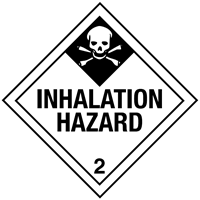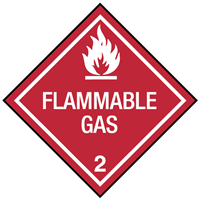
 Print
Print
Chemical Datasheet
CARBON DIOXIDE AND ETHYLENE OXIDE MIXTURE, WITH MORE THAN 87% ETHYLENE OXIDE |


|
Chemical Identifiers
| CAS Number |
UN/NA Number |
DOT Hazard Label |
USCG CHRIS Code |
- 124-38-9

- 75-21-8

|
|
|
none
|
| NIOSH Pocket Guide |
International Chem Safety Card |
|
Ethylene oxide
|
- CARBON DIOXIDE
- ETHYLENE OXIDE
|
NFPA 704
data unavailable
General Description
A gas with an ethereal odor. Flammable over a wide vapor to air concentration range. Toxic by inhalation. Vapors heavier than air. Under prolonged exposure to fire or intense heat the containers may violently rupture and rocket. Used as a fumigant.
Hazards
Reactivity Alerts
- Highly Flammable
- Explosive
- Polymerizable
Air & Water Reactions
Highly flammable. Carbon dioxide is water soluble, and forms carbonic acid, a mild acid in water.
Fire Hazard
Excerpt from ERG Guide 119

[Gases - Toxic - Flammable; polymerization hazard]:
Flammable; may be ignited by heat, sparks or flames. May form explosive mixtures with air. Ethylene oxide (UN1040) may react explosively even in the absence of air. Those substances designated with a (P) may polymerize explosively when heated or involved in a fire. Vapors from liquefied gas are initially heavier than air and spread along ground. Vapors may travel to source of ignition and flash back. Some of these materials may react violently with water. Cylinders exposed to fire may vent and release toxic and flammable gas through pressure relief devices. Containers may explode when heated. Ruptured cylinders may rocket. Runoff may create fire or explosion hazard. (ERG, 2024)
Health Hazard
Excerpt from ERG Guide 119

[Gases - Toxic - Flammable; polymerization hazard]:
TOXIC; may be fatal if inhaled or absorbed through skin. Some may cause severe skin burns and eye damage. Contact with gas or liquefied gas may cause burns, severe injury and/or frostbite. Fire will produce irritating, corrosive and/or toxic gases. Runoff from fire control or dilution water may cause environmental contamination. (ERG, 2024)
Reactivity Profile
Ethylene oxide is a colorless gas at room temperature (b.p. 11°C) and a confirmed carcinogen. Highly flammable, severe explosion hazard when exposed to flame. The autoignition temperature may be as low as 140°C in presence of rust. Rapid compression of the vapor with air causes explosion. Ethylene oxide vapor may be initiated into explosive decomposition in absence of air [Hess, L. G., et al., Ind. Eng. Chem., 1950, 42, p. 1251]. Metal fittings containing magnesium, copper or silver should be avoided, since traces of acetylene in ethylene oxide may produce metal acetylides capable of detonating the vapor [MCA SD-38, 1971]. Violent polymerization occurs on contact with strong bases (alkali hydroxides, ammonia) or acids, amines, metallic potassium, oxides (aluminum oxide, iron oxide, rust), covalent halides (aluminum chloride, ferric chloride, tin(IV) chloride) [Gupta, A. K., J. Soc. Chem. Ind., 1949, 68, p. 179]. Violent reaction with m-nitroaniline, magnesium perchlorate, mercaptans, thiols, triethylamine [Bretherick, 5th ed., 1995, p. 316]. Dusts of magnesium, lithium, potassium, sodium, zirconium, titanium, and some magnesium-aluminum alloys, and heated aluminum, chromium, and magnesium when suspended in carbon dioxide are ignitable and explosive. This is especially true in the presence of strong oxidizers, such as peroxides. The presence of carbon dioxide in solutions of aluminum hydride in ether can cause violent decomposition on warming the residue, [J. Amer. Chem. Soc., 1948, 70, 877]. Dangers arising from the use of carbon dioxide in the fire prevention and extinguishing systems of confined volumes of air and flammable vapors are examined. The hazard associated with its use centers around the fact that large electrostatic discharges may be created that initiate explosion, [Quart. Saf. Summ., 1973, 44(1740), 10].
Belongs to the Following Reactive Group(s)
- Epoxides
- Polymerizable Compounds
Potentially Incompatible Absorbents
Use caution: Liquids with this reactive group classification have been
known to react with the
absorbents
listed below.
- Mineral-Based & Clay-Based Absorbents
- Dirt/Earth
Response Recommendations
Isolation and Evacuation
Excerpt from ERG Guide 119

[Gases - Toxic - Flammable; polymerization hazard]:
IMMEDIATE PRECAUTIONARY MEASURE: Isolate spill or leak area for at least 100 meters (330 feet) in all directions.
SPILL: See ERG Table 1 - Initial Isolation and Protective Action Distances on the UN/NA 3300 datasheet.
FIRE: If tank, rail tank car or highway tank is involved in a fire, ISOLATE for 1600 meters (1 mile) in all directions; also, consider initial evacuation for 1600 meters (1 mile) in all directions. (ERG, 2024)
Firefighting
Excerpt from ERG Guide 119

[Gases - Toxic - Flammable; polymerization hazard]:
DO NOT EXTINGUISH A LEAKING GAS FIRE UNLESS LEAK CAN BE STOPPED.
SMALL FIRE: Dry chemical, CO2, water spray or alcohol-resistant foam.
LARGE FIRE: Water spray, fog or alcohol-resistant foam. FOR CHLOROSILANES, DO NOT USE WATER; use alcohol-resistant foam. If it can be done safely, move undamaged containers away from the area around the fire. Damaged cylinders should be handled only by specialists.
FIRE INVOLVING TANKS: Fight fire from maximum distance or use unmanned master stream devices or monitor nozzles. Cool containers with flooding quantities of water until well after fire is out. Do not direct water at source of leak or safety devices; icing may occur. Withdraw immediately in case of rising sound from venting safety devices or discoloration of tank. ALWAYS stay away from tanks in direct contact with flames. (ERG, 2024)
Non-Fire Response
Excerpt from ERG Guide 119

[Gases - Toxic - Flammable; polymerization hazard]:
ELIMINATE all ignition sources (no smoking, flares, sparks or flames) from immediate area. All equipment used when handling the product must be grounded. Do not touch or walk through spilled material. Stop leak if you can do it without risk. Do not direct water at spill or source of leak. Use water spray to reduce vapors or divert vapor cloud drift. Avoid allowing water runoff to contact spilled material. FOR CHLOROSILANES, use alcohol-resistant foam to reduce vapors. If possible, turn leaking containers so that gas escapes rather than liquid. Prevent entry into waterways, sewers, basements or confined areas. Isolate area until gas has dispersed. (ERG, 2024)
Protective Clothing
Excerpt from ERG Guide 119(P) [Gases - Toxic - Flammable; polymerization hazard]:
Wear positive pressure self-contained breathing apparatus (SCBA). Wear chemical protective clothing that is specifically recommended by the manufacturer when there is NO RISK OF FIRE. Structural firefighters' protective clothing provides thermal protection but only limited chemical protection. (ERG, 2024)
DuPont Tychem® Suit Fabrics
Normalized Breakthrough Times (in Minutes)
| Chemical |
CAS Number |
State |
QS |
QC |
SL |
C3 |
TF |
TP |
RC |
TK |
RF |
| Epoxy ethane (-70°C, liquid) |
75-21-8 |
Liquid |
|
|
|
|
|
|
|
>180 |
|
| Epoxy ethane (0°C, liquid) |
75-21-8 |
Liquid |
|
|
|
|
|
|
>480 |
>480 |
>480 |
| Epoxy ethane (10% in HCFC) |
75-21-8 |
Vapor |
|
|
|
|
|
|
|
>480 |
|
| Epoxy ethane (11°C, liquid) |
75-21-8 |
Liquid |
|
|
|
18 |
|
|
|
|
|
| Epoxy ethane (gaseous) |
75-21-8 |
Vapor |
|
imm |
imm |
12 |
126 |
>480 |
>480 |
>480 |
>480 |
| Ethylene oxide (-70°C, liquid) |
75-21-8 |
Liquid |
|
|
|
|
|
|
|
>180 |
|
| Ethylene oxide (0°C, liquid) |
75-21-8 |
Liquid |
|
|
|
|
|
|
>480 |
>480 |
>480 |
| Ethylene oxide (10% in HCFC) |
75-21-8 |
Vapor |
|
|
|
|
|
|
|
>480 |
|
| Ethylene oxide (11°C, liquid) |
75-21-8 |
Liquid |
|
|
|
18 |
|
|
|
|
|
| Ethylene oxide (gaseous) |
75-21-8 |
Vapor |
|
imm |
imm |
12 |
126 |
>480 |
>480 |
>480 |
>480 |
Special Warning from DuPont: Tychem® and Tyvek® fabrics should not be
used around heat, flames, sparks or in potentially flammable or
explosive environments. Only...
(DuPont, 2024)
First Aid
Excerpt from ERG Guide 119

[Gases - Toxic - Flammable; polymerization hazard]:
Refer to the "General First Aid" section. Specific First Aid: In case of contact with liquefied gas, only medical personnel should attempt thawing frosted parts. In case of burns, immediately cool affected skin for as long as possible with cold water. Do not remove clothing if adhering to skin. (ERG, 2024)
Physical Properties
| Chemical Formula: |
- CO2 (carbon dioxide)
- C2H4O (ethylene oxide)
|
Flash Point: data unavailable
Lower Explosive Limit (LEL): data unavailable
Upper Explosive Limit (UEL): data unavailable
Autoignition Temperature: data unavailable
Melting Point: data unavailable
Vapor Pressure: data unavailable
Vapor Density (Relative to Air): data unavailable
Specific Gravity: data unavailable
Boiling Point: data unavailable
Molecular Weight: data unavailable
Water Solubility: data unavailable
Ionization Energy/Potential:
10.56 eV
[From NPG: Ethylene oxide]
(NIOSH, 2024)
IDLH:
800 ppm
; A potential occupational carcinogen. [From NPG: Ethylene oxide]
(NIOSH, 2024)
AEGLs (Acute Exposure Guideline Levels)
Final AEGLs for Ethylene oxide (75-21-8)
| Exposure Period |
AEGL-1 |
AEGL-2 |
AEGL-3 |
| 10 minutes |
NR |
80 ppm |
360 ppm |
| 30 minutes |
NR |
80 ppm |
360 ppm |
| 60 minutes |
NR |
45 ppm |
200 ppm |
| 4 hours |
NR |
14 ppm |
63 ppm |
| 8 hours |
NR |
7.9 ppm |
35 ppm |
(NAC/NRC, 2024)
ERPGs (Emergency Response Planning Guidelines)
| Chemical |
ERPG-1 |
ERPG-2 |
ERPG-3 |
| Ethylene Oxide (75-21-8)
|
NA |
50 ppm |
500 ppm |
(AIHA, 2022)
PACs (Protective Action Criteria)
| Chemical |
PAC-1 |
PAC-2 |
PAC-3 |
|
| Carbon dioxide (124-38-9)
|
54000 mg/m3 |
72000 mg/m3 |
90000 mg/m3 |
|
| Ethylene oxide; (Oxirane) (75-21-8)
|
5 ppm |
45 ppm |
200 ppm |
LEL = 30000 ppm |
(DOE, 2024)
Regulatory Information
EPA Consolidated List of Lists
| Regulatory Name |
CAS Number/
313 Category Code |
EPCRA 302
EHS TPQ |
EPCRA 304
EHS RQ |
CERCLA RQ |
EPCRA 313
TRI |
RCRA
Code |
CAA 112(r)
RMP TQ |
| Ethylene oxide |
75-21-8 |
1000 pounds |
10 pounds |
10 pounds |
313 |
U115 |
10000 pounds |
| Oxirane |
75-21-8 |
1000 pounds |
10 pounds |
10 pounds |
X |
U115 |
10000 pounds |
(EPA List of Lists, 2024)
CISA Chemical Facility Anti-Terrorism Standards (CFATS)
|
RELEASE |
THEFT |
SABOTAGE |
| Chemical of Interest |
CAS Number |
Min Conc |
STQ |
Security
Issue |
Min Conc |
STQ |
Security
Issue |
Min Conc |
STQ |
Security
Issue |
| Ethylene oxide; [Oxirane] |
75-21-8 |
1.00 % |
10000 pounds |
flammable |
|
|
|
|
|
|
(CISA, 2007)
OSHA Process Safety Management (PSM) Standard List
| Chemical Name |
CAS Number |
Threshold Quantity (TQ) |
| Ethylene Oxide |
75-21-8 |
5000 pounds |
(OSHA, 2019)
Alternate Chemical Names
- CARBON DIOXIDE AND ETHYLENE OXIDE MIXTURE, WITH MORE THAN 87% ETHYLENE OXIDE
- ETHYLENE OXIDE AND CARBON DIOXIDE MIXTURE, WITH MORE THAN 87% ETHYLENE OXIDE



 Print
Print

